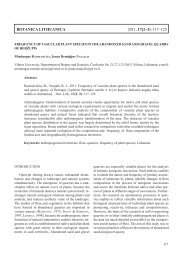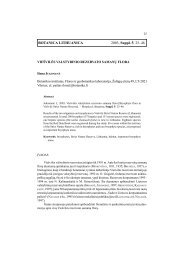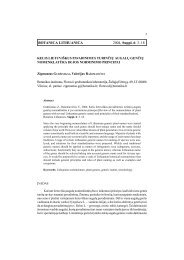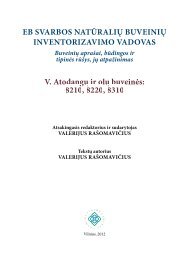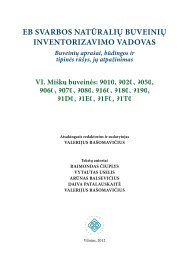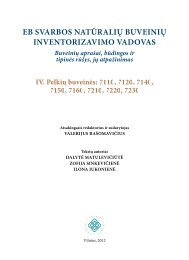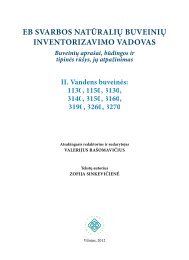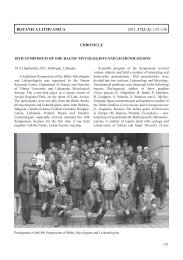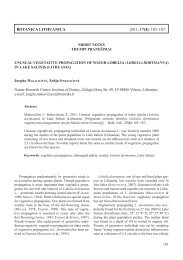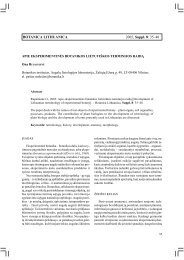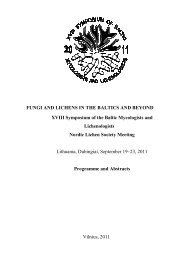BOTANICA LITHUANICA 2005, Suppl. 7: 65–75
BOTANICA LITHUANICA 2005, Suppl. 7: 65–75
BOTANICA LITHUANICA 2005, Suppl. 7: 65–75
- No tags were found...
You also want an ePaper? Increase the reach of your titles
YUMPU automatically turns print PDFs into web optimized ePapers that Google loves.
Penicillium palitans, P. roquefortii and P. viridicatum.These fungi were prevalent in the air of grain, vegetableand fruit storehouses. Thin-layer chromatographymethod was used for the analysis of micromycete capabilityto produce exogenic secondary metabolites. It wasrevealed that more than a half of all tested strains couldproduce more than one metabolite. Only a part of metaboliteswere identified because of the absence of standardtoxins (Table 3).On carrots, kept in storehouse, micromycetes of thePenicillium genus, many of which could be attributed totoxin-producers, were dominant. Penicillium and Aspergillusfungi, which are toxin-producers, mostly damageonions (Aspergillus niger, Penicillium expansum, P. aurantioviolaceum.P. spinulosum). Micromycetes of thePenicillium and Aspergillus genera were prevalent oncabbages stored for different time under different conditions.Fusarium oxysporum, Penicillium expansum, P. fellutanum,P. granulatum, Pythium catenulatum, Rhizopusoryzae and Verticillium alboatrum most often deterioratepotatoes.Micromycetes of 20 genera were isolated from apples.However, their distribution frequency differed.Predominant fungi were Aspergillus niger, Monilia cinerea,Penicillium biforme, P. corymbiferum, P. expansum,P. italicum, Pleospora fructicola and Rhizopus oryzae.The most abundant were Penicillium italicum, P. granulatumand P. corymbiferum.Mostly Penicillium corymbiferum, P. granulatum,P. italicum, P. aurantiovirens, Fusarium moniliforme,Phoma prunicola and Glomerella cingulata fungicontaminated cherry-beries. Toxic micromycetes Penicilliumexpansum, P. italicum and P. martensii deterioratedcurrant-berries most frequently. A direct relationshipbetween capability and intensity of mycotoxinsynthesis and substrate of cultivation of fungal strainsfor longer duration was detected (Table 4 and Table 5).The micromycetes producing toxins most intensivelywere detected, and intensity of the synthesis wasTable 3.Chromatographic characteristics (in BAC solvent system) of metabolites produced by micromycetes on differentmedia (AM – malt agar; CYA – Czapek with yeast extract; YES – yeast extract with sucrose)Fungal species Media Constant of Secondary metabolitesTLC R fPenicillium expansum sv–168-1 AM 0.59 PatulinAM 0.65 CitochalazinAM 0.69 Tenuazonic acid?CYA 0.64 CitochalazinCYA 0.68 Tenuazonic acid?YES 0.57 PatulinYES 0.72 Tenuazonic acidFusarium solani F–08 AM 0.63 Citochalazin?CYA 0.61 Citochalazin?YES 0.56 Patulin?YES 0.62 Citochalazin?Alternaria alternata B–230-1 AM 0.59 PatulinAM 0.65 CitochalazinAM 0.87 PeritremCladosporium chlorocephalum 3-pk AM 0.89 Sterigmatocistin?Ulocladium oudemansii B-230-2 AM 0.72 Tenuazonic acid?AM 0.86 SterigmatocistinAlternaria pluriseptata B-230-3 AM 0.76 Tenuazonic acidAM 0.80 CitochalazinScytalidium lignicola G-453 AM 0.87 Sterigmatocistin?Alternaria sp. M-447 AM 0.83 CitochalazinAspergillus raperi 2-Ši 2-ÐiAM 0.74 Tenuazonic acidAM 0.84 SterigmatocistinChrysosporium merdarium 1-Šal 0.54 Patulin?AM 0.73 Tenuazonic acid70



